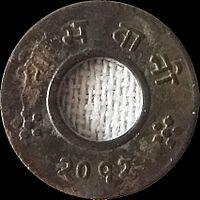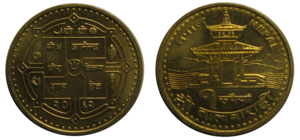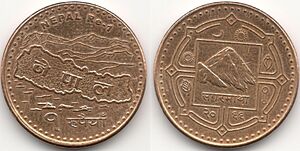Nepalese rupee facts for kids
Quick facts for kids Nepalese rupee |
|
|---|---|
| ISO 4217 Code | NPR |
| User(s) | Kingdom of Nepal (1932–2008), |
| Inflation | 3.6% (2021) |
| Source | Statista |
| Pegged with | ₹1 = रु.1.60 (buy) ₹1 = रु.1.6015 (sell) |
| Subunit | |
| 1⁄100 | Paisa |
| Symbol | रु. |
| Coins | |
| Freq. used | रु. 1, रु. 2 |
| Rarely used | 1, 5, 10, 25, 50 paisa, रु. 5, रु. 10 |
| Banknotes | |
| Freq. used | रु. 5, रु. 10, रु. 20, रु. 50, रु. 100, रु. 500, रु. 1000 |
| Rarely used | रु. 1, रु. 2, रु. 25, रु. 250 |
The Nepalese rupee (called Rupaiyām̐ in Nepali) is the official money of Nepal. Its symbol is रु. and its code is NPR. One Nepalese rupee is made up of 100 smaller units called paisa.
The Nepal Rastra Bank, which is Nepal's central bank, is in charge of printing and managing the currency. The Nepalese rupee started being used in 1932. It took the place of the old Nepalese mohar, with 2 mohars being worth 1 rupee.
Since 1994, the Nepalese rupee has been connected to the Indian rupee. This means that 1 Indian rupee is always worth 1.60 Nepalese rupees. Before 1994, the rate was 1 Indian rupee for 1.45 Nepalese rupees.
Contents
History of the Nepalese Rupee
The rupee first appeared in 1932. It replaced the silver mohar at a rate of 2 mohars for 1 rupee. When it was first introduced, people in Nepal sometimes called the rupee Mohru.
The Special "Bullet Paisa" Coin
In 1955, a very unique 4 Paisa coin was made. These coins were special because they were created from old rifle cartridge cases. These cases came from World War II and were used by brave Gurkha soldiers. The Gurkhas fought against the Imperial Japanese in the Pacific.
To make these coins, the small explosive part (primer) was removed from the cartridge cases. Then, the cases were turned into 4 Paisa coins. This was done to remember the Gurkhas' bravery and their victory in the war. Because there were not many cases available, these special coins were only made for one year. Today, they are famously known as the "Nepal Bullet Paisa".
Banknotes from 1972 to 2007
During the time of King Birendra, there were two main types of banknotes. On the first type, the king wore a military uniform. On the second type, he wore a traditional Nepalese crown with bird feathers. During this period, new banknotes were made for the first time. These included 2 and 20 rupee notes, and special 25 and 250 rupee notes.
Later, under King Gyanendra, the words on the banknotes changed. They started saying "Nepal sarkar" (meaning "Nepalese government"). This removed the direct mention of the king.
Banknotes from 2007 to Today
In October 2007, a 500-rupee note was released. On this note, the king's picture was replaced with Mount Everest. This change showed the big shift in Nepal from a kingdom to a republic in May 2008.
More notes followed in 2008, including 5, 10, 20, 50, 100, and 1000 rupee notes. These also featured Mount Everest and did not mention the king. The first 500 and 1000 rupee notes were printed on paper that still had the king's picture as a watermark. To cover this, a red Rhododendron flower (Nepal's national flower) was printed over the watermark.
Notes printed from 2009 onwards have the Rhododendron flower as the watermark instead of the king's picture. So, these newer notes do not need the red overprint.
Nepalese Banknotes
On September 17, 1945, the government first introduced banknotes for 5, 10, and 100 rupees. In Nepali, these were still called mohru. There were also special 250-rupee notes made in 1997. These notes celebrated the 25th anniversary of King Birendra Bir Bikram Shah's rule. Since 2007, the company that prints Nepal's banknotes is Perum Peruri from Indonesia.
In 2012, the Nepal Rastra Bank released a new series of banknotes. They looked similar to the 2007 notes but now included English words and the year they were made on the back.
| Image | Value (rupees) |
Main colours | Description | Date of issue |
||
|---|---|---|---|---|---|---|
| Obverse | Reverse | Obverse | Reverse | |||
| 5 | Lilac and pink | Mount Everest; temple of Taleju; obverse of coin | Two yaks grazing; Mount Everest | 2012 | ||
| Mount Everest; Kasthamandap Temple | Yak | 2017 | ||||
| 10 | Brown and green | Mount Everest; Garud Narayan of Changu Narayan temple | Three blackbucks grazing; trees; bank logo | 2012 | ||
| Antelope; trees; bank logo | 2017 | |||||
| 20 | Orange and brown | Mount Everest; temple of god Krishna of Patan; Garuda atop pillar | Swamp deer; trees; mountain; bank logo | 2012 | ||
| Sambar deer; trees; mountain; bank logo | 2016 | |||||
| 50 | Purple, green and blue | Mount Everest; Rama-Janaki temple of Janakpur | Male tahr; mountains; bank logo | 2012 | ||
| Snow leopard; bank logo | 2016 | |||||
| 100 | Green and lilac | Mount Everest; Mayadevi inside silver metallic oval; map of Nepal; Ashoka pillar; wood carvings from temple of Taleju in Kathmandu; description "Lumbini – Birthplace of Lord Buddha" |
One-horned rhinoceros in grassy plain; bank logo | 2012 | ||
| One-horned rhinoceros and its offspring in grassy plain; bank logo | 2015 | |||||
| 500 | Brown and violet | Mount Everest; god Indra; Mount Amadablam and Thyangboche monastery; wood carvings; clouds | Two tigers drinking melted snow | 2012 | ||
| Tiger | 2016 | |||||
| 1,000 | Blue and gray | Mount Everest, Swayambhunath Stupa & Harati temple | Asian elephant | 2013 | ||
| Twin Asian Elephants | 2019 | |||||
| For table standards, see the banknote specification table. | ||||||
How Exchange Rates Work
An exchange rate tells you how much one country's money is worth compared to another's.
Between 1857 and 1930, the Nepalese rupee had a fixed value against the Indian rupee. This meant 1.28 Nepalese rupees were equal to 1 Indian rupee. After 1930, its value changed a lot. For example, in 1939, 1 Indian rupee was worth 1.60 Nepalese rupees. During Second World War, it even went up to 0.60 Nepalese rupees for 1 Indian rupee.
In 1952, the government of Nepal officially set the rate at 1.28 Nepalese rupees for 1 Indian rupee. However, in the market, people were still trading at 1.60 Nepalese rupees for 1 Indian rupee.
Between 1955 and 1957, the value of the Nepalese rupee slowly changed. It started at 1.755 Nepalese rupees for 1 Indian rupee and became stronger, reaching 1.305 Nepalese rupees for 1 Indian rupee by 1957. In 1958, a new rate of 1.505 Nepalese rupees for 1 Indian rupee was used only for buying plane tickets.
A fixed rate of 1.60 Nepalese rupees for 1 Indian rupee was set in 1960. This rate changed to 1.0155 Nepalese rupees for 1 Indian rupee when the Indian rupee lost a lot of its value on June 6, 1966. After 1966, the Indian rupee was no longer official money in Nepal.
From 1967 to 1975, Nepal's government linked the Nepalese rupee to the Indian rupee, the US dollar, and gold. For example, 1.35 Nepalese rupees were equal to 1 Indian rupee. By 1978, when the link to gold was removed, the rate was 1.39075 Nepalese rupees for 1 Indian rupee.
In 1983, the Nepalese rupee's value was linked to a group of different currencies. In simple terms, this meant it was strongly linked to the Indian rupee. This continued until 1993, when the official fixed rate was set at 1.60 Nepalese rupees for 1 Indian rupee.
See also
- Crore
- Economy of Nepal
- Coinage of Nepal
| Current NPR exchange rates | |
|---|---|
| From Google Finance: | AUD CAD CHF EUR GBP HKD JPY USD INR EUR JPY |
| From Yahoo! Finance: | AUD CAD CHF EUR GBP HKD JPY USD INR EUR JPY |
| From XE.com: | AUD CAD CHF EUR GBP HKD JPY USD INR EUR JPY |
| From OANDA: | AUD CAD CHF EUR GBP HKD JPY USD INR EUR JPY |
| From fxtop.com: | AUD CAD CHF EUR GBP HKD JPY USD INR EUR JPY |







